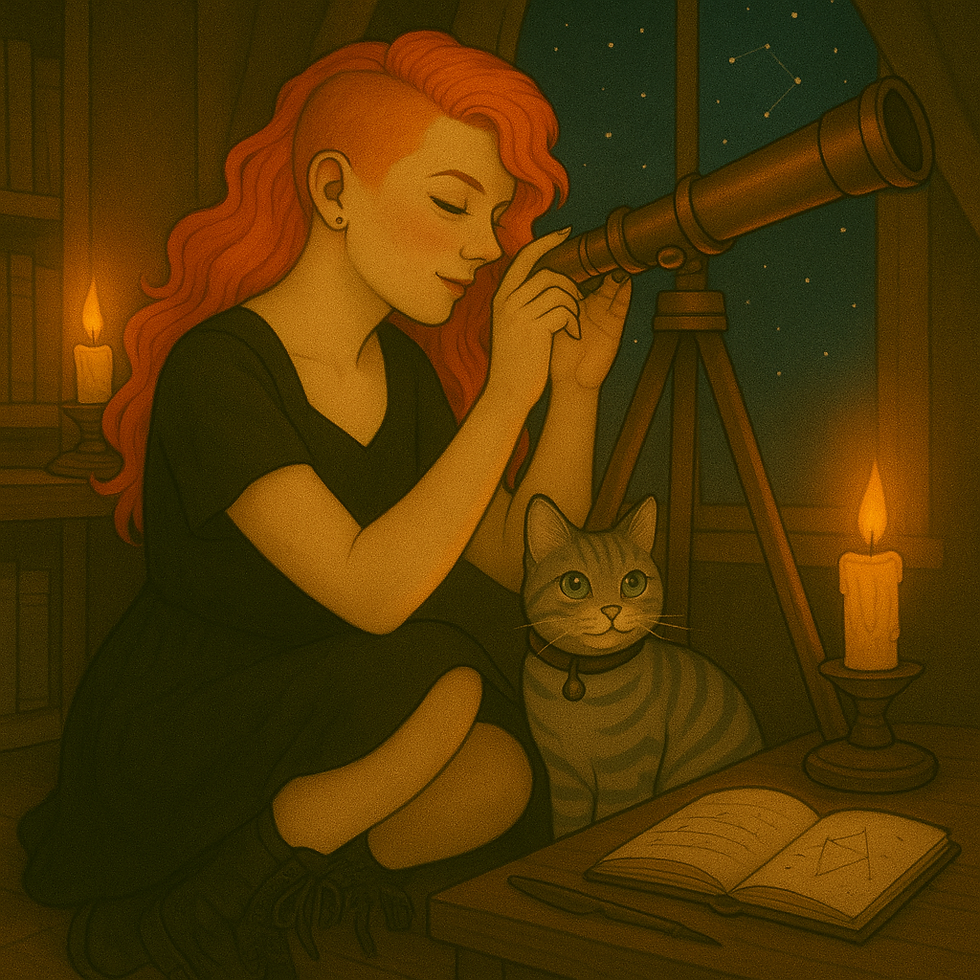Myth, Moons, and Mischief: A Guide to the Names in Our Sky
- Signa Gillysdottir
- Aug 30
- 3 min read
Welcome back to the History Nook.

Today we’re exploring Roman mythology and the solar system—looking at the relationship between the names of the planets and their moons.
So grab your favourite mug, find a soft space to curl up, and let’s wander a little deeper into the past… and the void. This post is brought to you by a random conversation I had this afternoon with one of my favourite humans.
Mercury and Venus have no moons (that we know of). Mercury is named after the Roman god of communication, travel, and trickery—he’s the Roman version of Hermes. Venus is the Roman goddess of beauty, love, sex, and fertility, and her Greek counterpart is Aphrodite.
Earth is an interesting one. Instead of being named after a Roman deity, the name comes from the Anglo-Saxon word for “ground.” (We just had to be different.) The name “Moon” comes from Old English. And Earth, while it has just the one official moon, also has a whole host of smaller satellites orbiting it that don’t quite meet the classification of moons.
Mars, the Roman god of war—a fitting name for the red planet. Mars’ moons are called Phobos and Deimos, which mean “fear” and “dread” in Greek. Why Greek, you may ask? Mars is the Roman equivalent of Ares, the Greek god of war, and his attendants were, you guessed it, Phobos and Deimos.
I asked Leo if that mean Dreadnought in Greek would be Deimosmeden? - He refused to answer.
Jupiter, named after the Roman god of the sky and thunder, has a lot of moons—a lot. It makes sense that the biggest planet in the solar system would be named after Jupiter, the Roman equivalent of Zeus. Am I going to list all 97 moons? No. We’ll focus on a handful, known as the Galilean moons.
As with Phobos and Deimos, these moons are named after figures in Greek mythology. Io was one of Zeus’ lovers; Europa was abducted by Zeus (delightful…); Callisto’s story varies but—yes—Zeus was involved; and Ganymede? A beautiful prince who was, you guessed it, abducted by Zeus. Are you beginning to see a pattern here?
One of my favourite little Jupiter facts: some comedic genius at NASA thought it would be hilarious to name the probe visiting Jupiter Juno. They basically sent the wife to check on her husband—and I love that.
When it comes to moons, Saturn got a bit greedy. Who in their right mind needs 274 moons? Oh… the god of wealth and abundance. Fair enough, Saturn, you can have that one. Saturn’s Greek counterpart isn’t an Olympian god but a Titan—Cronos. That explains why one of Saturn’s moons is called Titan. The larger moons are named after other Titans, including Rhea (wife of Cronos), Enceladus, Prometheus, Phoebe (grandmother of Apollo), Hyperion (brother of Cronos), and Tethys.
The smaller moons are split into three groups: the Inuit, Norse, and Gallic moons, each named from the mythologies and cultures of their group.
Uranus—finally, a planet named after a Greek entity! And I say entity because Uranus was a primordial god rather than an Olympian—he’s the personification of the sky. The name suits the planet well if you look at its colour. But Uranus’ moons don’t follow the same mythological pattern. Instead, they’re named after characters from English literature, particularly Shakespeare. They include Oberon and Titania from A Midsummer Night’s Dream.
Back to Rome for Neptune, the god of the sea. His Greek counterpart is Poseidon, and once again, the name is fitting for the planet’s striking blue colour. Neptune has a modest 16 moons, and once again many are named from Greek mythology. There’s Triton, Poseidon’s son; Thalassa, the primordial goddess of the sea; and Hippocamp, a mythical creature said to be half-horse, half-fish. And so on.
And finally, Pluto. Yes, I know, Pluto isn’t technically a planet anymore—but here’s a lovely little knowledge nugget: Pluto didn’t get “demoted.” Instead, an entire new classification was created for it—dwarf planets. This whole class is called “plutoids,” named after Pluto itself.
Pluto is the Roman god of the underworld, so it feels fitting that this lonely little world is the sentinel on the edge of the solar system. His Greek counterpart is Hades, and again, the moons follow Greek naming patterns. Charon, the largest, is named after the ferryman who carries souls across the River Styx. The others are Nix, Hydra, Kerberos, and Styx.
Thank you for reading—I hope you enjoyed your time in the History Nook today.
Until next time: stay curious, and keep warm.
🐾 A Footnote from Index: 🐾
Planets, moons, gods… call me when one of them is made of fish. Until then, I’ll stick to batting at the sunbeam on the wall.


Comments